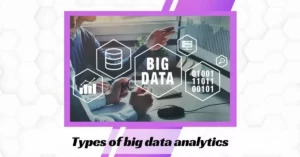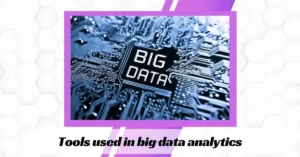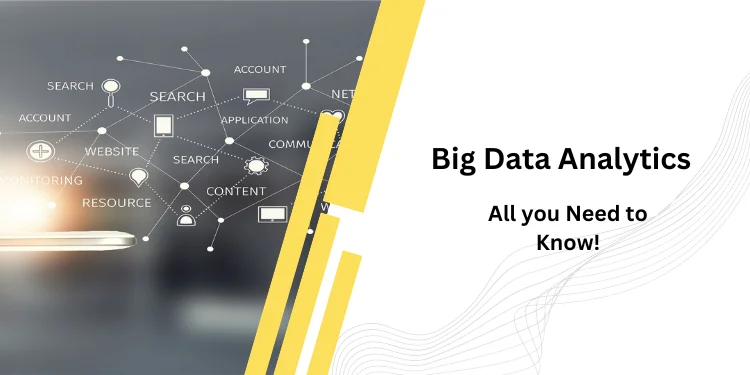Table of Contents
ToggleIntroduction
Your customers produce an enormous amount of data every day. big data analytics, Each time a person opens your email, uses your mobile app, mentions you on social media, or enters your store, these technologies collect and handle that data for your business, makes an online purchase, speaks to a customer care agent, or queries a virtual assistant about you. And those are just your clients. Employees, supply chains, marketing initiatives, finance departments, and more produce an immense amount of data every day.
Big data is a large volume of information and datasets that originate from numerous sources and take many different formats. Now that technology is developing quickly, businesses may employ big data to turn terabytes of data into useful insights.
What is Big Data Analytics?

In order to find market trends, insights, and patterns that might aid businesses in making better business decisions, data analytics is the process of gathering, reviewing, and analysing enormous amounts of data. Companies may create plans swiftly and efficiently with this information, maintaining their competitive advantage.
Businesses can gather structured and unstructured data from an array of sources using business intelligence (BI) tools and systems. Users’ (often employees’) input into these tools aids in understanding business performance and operations. The four data analysis techniques used by big data are used to find significant insights and develop solutions.
Why is Big Data Analytics Important?
Big data are essential because they allow firms to use their data to identify potential areas for development. Across all corporate sectors, improving efficiency results in more shrewd operations overall, more profits, and happy customers. Data analytics aids businesses in cost-cutting and the creation of superior, client-focused goods and services.
Data analytics helps to produce insights that improve how our society functions. data analytics is essential to evaluate COVID-19 outcomes globally in addition to monitoring and analysing individual patient records. It provides guidance to each country’s health ministries on how to proceed with immunisations and develops strategies for preventing pandemic outbreaks in the future.
Types of Big Data Analytics

Big data analytics are used to support and inform different company decisions and fall into four main areas.
1. Descriptive analytics
Data that is straightforward to read and analyse is referred to as descriptive analytics. These data can be used to generate reports and information that detail business sales and profitability.
Example
A top pharmaceutical corporation analysed data from its headquarters and research facilities during the pandemic. They found condensed underused areas and departments with the aid of descriptive analytics, which allowed the organisation to save millions of dollars.
2. Diagnostics analytics
Business organisations can better grasp problems by using diagnostic analytics. Users of big data technologies and tools can mine and retrieve data that aids in analysing problems and preventing them in the future.
Example
Although customers keep adding products to their shopping carts, a clothing company’s revenues have fallen. Diagnostic analytics assisted in determining why the payment page had been malfunctioning for a few weeks.
3. Predictive analytics
To develop forecasts, predictive analytics examines both historical and current data. Data mining, artificial intelligence (AI), and machine learning enable users to analyse information to forecast market trends.
Example
Companies in the manufacturing industry can forecast whether or when an item of equipment will fail or break down using algorithms based on historical data.
4. Prescriptive analytics
Prescriptive analytics uses AI and machine learning to collect data and utilise it for risk management, offering a solution to a problem.
Example
Utility firms, gas producers, and pipeline operators evaluate factors that influence the price of oil and gas within the energy industry in order to mitigate risks.
Click here to know more about: data science colleges in Pune
Tools Used in Big Data Analytics

It takes tools to use all of that data effectively. Thank goodness, straightforward software packages are now readily accessible for data analysts to employ thanks to advancements in technology.
Hadoop:
an open-source platform for storing and handling large amounts of data. Hadoop can manage and process both structured and unstructured data.
Spark:
a framework for open-source cluster computing that is used to process and analyse data in real-time.
Data integration software:
Programs like MongoDB, Apache, Hadoop, and Amazon EMR that ease the use of large data across several platforms.
Stream analytics tools:
systems that sort, assemble, and analyse data that may be kept on several platforms and in various formats, like Kafka.
Distributed storage:
databases like Cassandra that can distribute data over different servers and can detect lost or incorrect data.
Predictive analytics hardware and software:
Systems that analyse vast volumes of complicated data and forecast future events using machine learning and algorithms, including fraud detection, marketing, and risk assessments.
Data mining tools:
Utilizing both structured and unstructured big data, programmes that enable users to conduct searches.
Big Data Analytics Uses and Examples

A few examples of the ways data analytics may help organizations are provided below:
Customer acquisition and retention:
Consumer data may help businesses with their marketing efforts so they can capitalise on trends and raise customer satisfaction. Personalization tools for Spotify, Netflix, and Amazon, for instance, can enhance user satisfaction and foster loyalty.
Targeted ads:
Users can benefit
from effective targeted ad campaigns that are created for them both on an individual level and on a broader scale using personalization data from sources including prior purchases, behaviour patterns, and histories of visiting product pages.
Product development:
Big data analytics can offer information regarding product feasibility, development choices, progress tracking, and how to enhance processes so that they better serve customers.
Price optimization:
Retailers may opt for pricing models that incorporate data from numerous data sources and model them in order to increase profitability.
Supply chain and channel analytics:
Proactive restocking, B2B supplier networks, inventory management, route enhancements, and delivery delay notification can all be aided by predictive analytical models.
Also read: data science course fees in Mumbai
Benefits of Big Data Analytics
Incorporating big data into a company or organisation has many benefits. These consist of:
Cost reduction:
Big data can lower expenses by centralising all commercial data storage. Monitoring analytics also enables businesses to identify areas where they can operate more cost-effectively.
Product development:
Based on data gathered from client needs and wants, creating and marketing new products, services, or brands is considerably simpler. data analytics also aids organisations in comprehending the viability of products and staying abreast of trends.
Strategic business decisions:
Businesses can optimise costs and supply chains and other decisions through the continuous analysis of data.
Customer experience:
By providing an improved customer experience, data-driven algorithms support marketing initiatives (targeted advertisements, for instance) and raise consumer satisfaction.
Risk management:
By examining data trends, businesses can find hazards and create solutions to manage those risks.
Conclusion
Today’s largest and most successful businesses are being propelled forward by big data analytics. In a world of intense competition, businesses who can transform data into information and information into insights will be the ones that own the future. Uber, for instance, upended the taxi industry, and Airbnb upended the lodging industry.
Due to the sheer power of their deep data analytical attitude, both of these businesses are thriving. So, the best course of action for any firm worth its salt is to adopt a clear data-driven strategy and utilise transformational data analytics methodologies to tap into the power of big data.
Frequently Asked Questions
What are the 5 big data analytics?
The five V’s—velocity, volume, value, variety, and veracity—are the five main and basic characteristics of big data. Understanding the 5 V’s enables data scientists to get more value out of their data and helps the organisation where they work become more customer-centric.
What is big data analytics example?
Thanks to big data analytics, businesses can learn from the massive amounts of data already available. Individuals, companies, and machines now produce enormous amounts of data. Social media, cloud applications, and sensor data from machines are some examples.
Where is big data analytics used?
- Banking and Securities.
- Communications, Media and Entertainment.
- Healthcare Providers.
- Education.
- Manufacturing and Natural Resources.
- Government.
- Insurance.
- Retail and Wholesale trade.
What is big data analytics used for?
Big data analytics is the act of spotting patterns, trends, and correlations in vast quantities of unprocessed data in order to support data-driven decision-making. With the use of more modern tools, these approaches apply well-known statistical analysis techniques to larger datasets, such as clustering and regression.
What is data analytics tools?
Data analysis tools are programs and software that collect and analyze data about a business, its customers, and its rivals so as to streamline operations and identify trends that may be used to inform choices.
What is big data in AI?
Large amounts of data that may be produced, processed, and increasingly employed by digital tools and information devices for generating predictive, descriptive, and prescriptive analyses are referred to as big data analytics (BDA).













